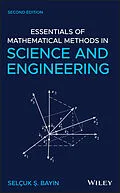A comprehensive introduction to the multidisciplinary applications of mathematical methods, revised and updated The second edition of Essentials of Mathematical Methods in Science and Engineering offers an introduction to the key mathematical concepts of advanced calculus, differential equations, complex analysis, and introductory mathematical physics for students in engineering and physics research. The book's approachable style is designed in a modular format with each chapter covering a subject thoroughly and thus can be read independently. This updated second edition includes two new and extensive chapters that cover practical linear algebra and applications of linear algebra as well as a computer file that includes Matlab codes. To enhance understanding of the material presented, the text contains a collection of exercises at the end of each chapter. The author offers a coherent treatment of the topics with a style that makes the essential mathematical skills easily accessible to a multidisciplinary audience. This important text: * Includes derivations with sufficient detail so that the reader can follow them without searching for results in other parts of the book * Puts the emphasis on the analytic techniques * Contains two new chapters that explore linear algebra and its applications * Includes Matlab codes that the readers can use to practice with the methods introduced in the book Written for students in science and engineering, this new edition of Essentials of Mathematical Methods in Science and Engineering maintains all the successful features of the first edition and includes new information.
Autorentext
SELÇUK . BAYIN, PHD, is Professor in the Institute of Applied Mathematics at the Middle East Technical University in Ankara, Turkey. He has over thirty years of academic experience on the use of mathematical methods in physics courses, and his current research focuses on general relativity and cosmology. He is the author of the first and second editions of Mathematical Methods in Science and Engineering, and Essentials of Mathematical Methods in Science and Engineering, from Wiley.
Inhalt
Preface xxiii
Acknowledgments xxix
1 Functional Analysis 1
1.1 Concept of Function 1
1.2 Continuity and Limits 3
1.3 Partial Differentiation 6
1.4 Total Differential 8
1.5 Taylor Series 9
1.6 Maxima and Minima of Functions 13
1.7 Extrema of Functions with Conditions 17
1.8 Derivatives and Differentials of Composite Functions 21
1.9 Implicit Function Theorem 23
1.10 Inverse Functions 28
1.11 Integral Calculus and the Definite Integral 30
1.12 Riemann Integral 32
1.13 Improper Integrals 35
1.14 Cauchy Principal Value Integrals 38
1.15 Integrals Involving a Parameter 40
1.16 Limits of Integration Depending on a Parameter 44
1.17 Double Integrals 45
1.18 Properties of Double Integrals 47
1.19 Triple and Multiple Integrals 48
References 49
Problems 49
2 Vector Analysis 55
2.1 Vector Algebra: Geometric Method 55
2.1.1 Multiplication of Vectors 57
2.2 Vector Algebra: Coordinate Representation 60
2.3 Lines and Planes 65
2.4 Vector Differential Calculus 67
2.4.1 Scalar Fields and Vector Fields 67
2.4.2 Vector Differentiation 69
2.5 Gradient Operator 70
2.5.1 Meaning of the Gradient 71
2.5.2 Directional Derivative 72
2.6 Divergence and Curl Operators 73
2.6.1 Meaning of Divergence and the Divergence Theorem 75
2.7 Vector Integral Calculus in Two Dimensions 79
2.7.1 Arc Length and Line Integrals 79
2.7.2 Surface Area and Surface Integrals 83
2.7.3 An Alternate Way to Write Line Integrals 84
2.7.4 Green's Theorem 86
2.7.5 Interpretations of Green's Theorem 88
2.7.6 Extension to Multiply Connected Domains 89
2.8 Curl Operator and Stokes's Theorem 92
2.8.1 On the Plane 92
2.8.2 In Space 96
2.8.3 Geometric Interpretation of Curl 99
2.9 Mixed Operations with the Del Operator 99
2.10 Potential Theory 102
2.10.1 Gravitational Field of a Star 105
2.10.2 Work Done by Gravitational Force 106
2.10.3 Path Independence and Exact Differentials 108
2.10.4 Gravity and Conservative Forces 109
2.10.5 Gravitational Potential 111
2.10.6 Gravitational Potential Energy of a System 113
2.10.7 Helmholtz Theorem 115
2.10.8 Applications of the Helmholtz Theorem 116
2.10.9 Examples from Physics 120
References 123
Problems 123
3 Generalized Coordinates and Tensors 133
3.1 Transformations between Cartesian Coordinates 134
3.1.1 Basis Vectors and Direction Cosines 134
3.1.2 Transformation Matrix and Orthogonality 136
3.1.3 Inverse Transformation Matrix 137
3.2 Cartesian Tensors 139
3.2.1 Algebraic Properties of Tensors 141
3.2.2 Kronecker Delta and the Permutation Symbol 145
3.3 Generalized Coordinates 148
3.3.1 Coordinate Curves and Surfaces 148
3.3.2 Why Upper and Lower Indices 152
3.4 General Tensors 153
3.4.1 Einstein Summation Convention 156
3.4.2 Line Element 157
3.4.3 Metric Tensor 157
3.4.4 How to Raise and Lower Indices 158
3.4.5 Metric Tensor and the Basis Vectors 160
3.4.6 Displacement Vector 161
3.4.7 Line Integrals 162
3.4.8 Area Element in Generalized Coordinates 164
3.4.9 Area of a Surface 165
3.4.10 Volume Element in Generalized Coordinates 169
3.4.11 Invariance and Covariance 171
3.5 Differential Operators in Generalized Coordinates 171
3.5.1 Gradient 171
3.5.2 Divergence 172
3.5.3 Curl 174
3.5.4 Laplacian 178
3.6 Orthogonal Generalized Coordinates 178
3.6.1 Cylindrical Coordinates 179&...
